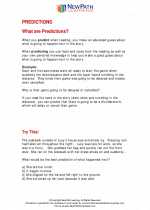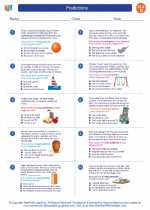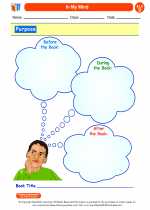Predictions
What are Predictions? When predicting you use facts and clues from the reading as well as your own personal knowledge to help you make a good guess about what is going to happen next in the story. Read More...
◂English Language Arts Worksheets and Study Guides Fourth Grade. Predictions
Study Guide Predictions
Predictions  Worksheet/Answer key
Worksheet/Answer key Predictions
Predictions  Worksheet/Answer key
Worksheet/Answer key Predictions
Predictions  Worksheet/Answer key
Worksheet/Answer key Predictions
Predictions  Worksheet/Answer key
Worksheet/Answer key In My Mind
In My Mind 

 Worksheet/Answer key
Worksheet/Answer key
 Worksheet/Answer key
Worksheet/Answer key
 Worksheet/Answer key
Worksheet/Answer key
 Worksheet/Answer key
Worksheet/Answer key

The resources above cover the following skills:
Standards for Reading Literature (RL)
Key Ideas and Details
Anchor Standard: Read closely to determine what the text says explicitly and to make logical inferences from it; cite specific textual evidence when writing or speaking to support conclusions drawn from the text.
Refer to details and examples in a text when explaining what the text says explicitly and when drawing inferences from the text.
Apply appropriate strategies before reading, viewing, or listening to a text: preview and survey the text; access prior knowledge about the text; formulate purpose-setting questions; make predictions.
Apply appropriate strategies to monitor understanding when reading, viewing, or listening to a text: reread as necessary; determine main ideas of portions of the text; periodically restate, retell, paraphrase, summarize, and/or synthesize information (See CCSS SL.4.4-6); connect ideas within the text; make, confirm, and/or modify questions, inferences, and predictions; visualize.
Demonstrate understanding, either orally or in writing, after reading, viewing, or listening to a text: determine and explain main ideas (explicit or inferred) of the text; summarize the text (See CCSS SL.4.4-6; MD SLM 4-5 4A2); explain what is directly stated in the text by citing specific details and examples from the text; explain inferences, conclusions, and generalizations by citing appropriate details and examples from the text; synthesize information and ideas; confirm, refute, and/or make predictions about the text; connect prior knowledge or experience to the text.
Standards for Reading Informational Text (RI)
Key Ideas and Details
Anchor Standard: Read closely to determine what the text says explicitly and to make logical inferences from it; cite specific textual evidence when writing or speaking to support conclusions drawn from the text.
Refer to details and examples in a text when explaining what the text says explicitly and when drawing inferences from the text.
Apply appropriate strategies before reading, viewing, or listening to a text: preview and survey the text; access prior knowledge about the text; formulate purpose-setting questions; make predictions.
Apply appropriate strategies to monitor understanding when reading, viewing, or listening to a text: reread as necessary; determine main ideas of portions of the text; periodically restate, retell, paraphrase, summarize, and/or synthesize information (See CCSS SL.4.4, 6); connect ideas within the text; make, confirm, and/or modify questions, inferences, and predictions; visualize.
Demonstrate understanding, either orally or in writing, after reading, viewing, or listening to a text: determine and explain main ideas (explicit or inferred) of the text; summarize the text (See CCSS SL.4.4, 6; MD SLM 4-5 4A.2); explain what is directly stated in the text by citing specific details and examples from the text; explain inferences, conclusions, and generalizations by citing appropriate details and examples from the text; synthesize information and ideas; confirm, refute, and/or make predictions about the text; connect prior knowledge or experience to the text.